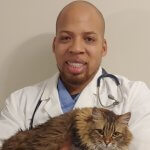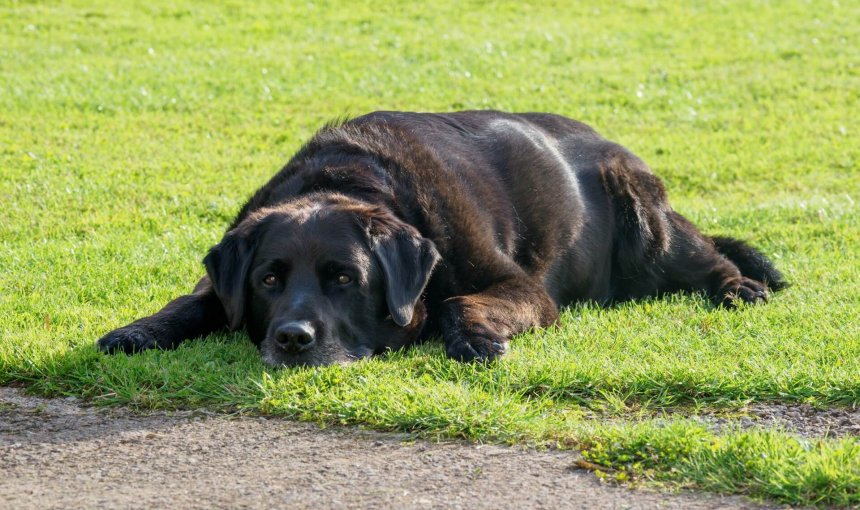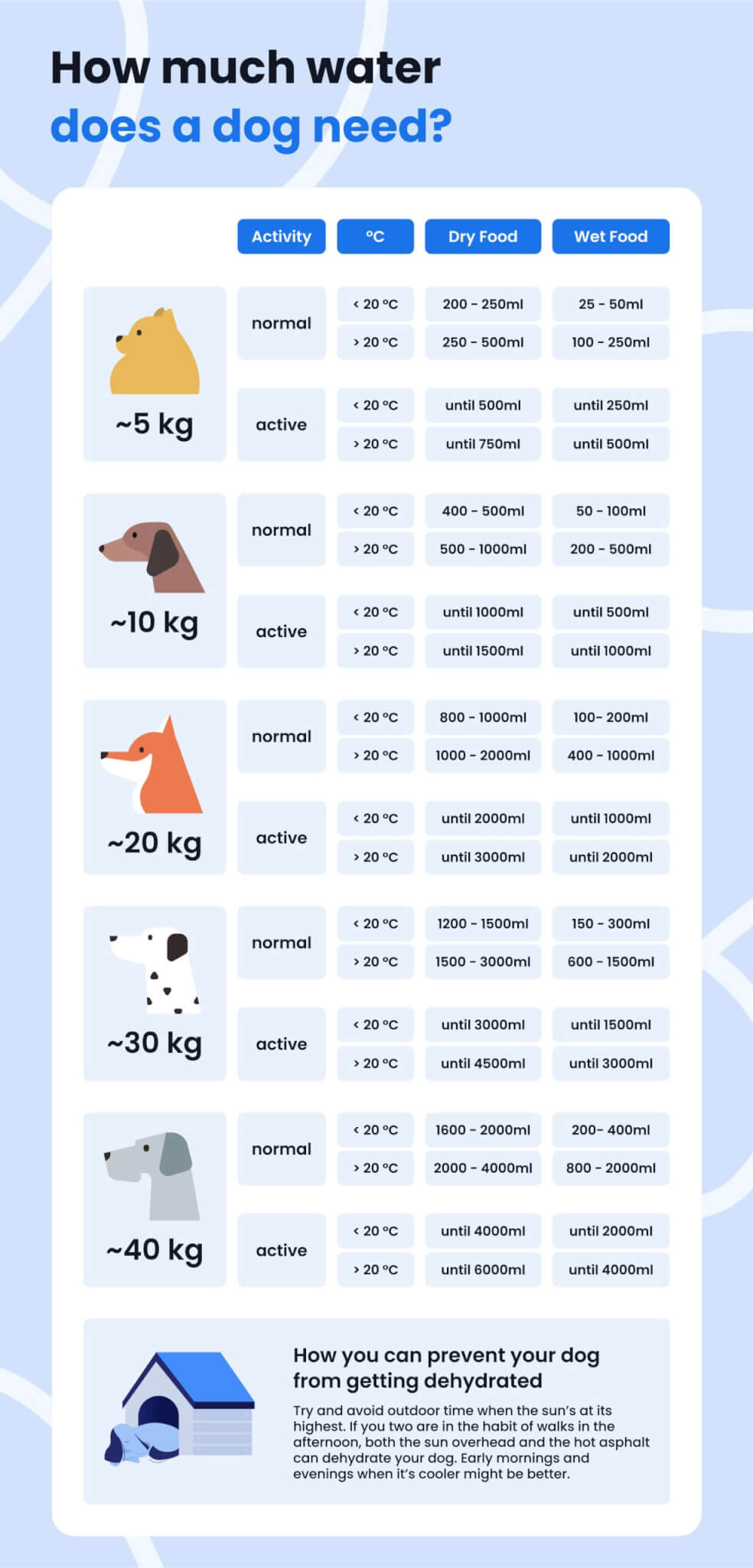 Approved by Dr. Dwight Alleyne, DVM
Approved by Dr. Dwight Alleyne, DVM Bloat In Dogs: Causes, Symptoms, Treatment & Prevention
Eating too much or too fast isn't just bad table manners, it's also pretty dangerous for your dog, health-wise! Here's why & what to do.

With Halloween and Thanksgiving coming up, you might be busy cooking up a storm…and watching your dog snarf up any food from the floor. Which could lead to them overeating or eating too fast – and ending up with a bad case of dog bloat. (A potentially life-threatening condition.) Here are the signs and symptoms to watch out for – and how to spot a potential health issue early.
Key Takeaways
Symptoms of dog bloat include a swollen or hard abdomen, retching, excessive drooling, restlessness, difficulty breathing, and signs of pain or distress.
Risk factors include eating too quickly, exercising after meals, stress, and genetics.
You can prevent dog bloat by feeding your dog smaller, more frequent meals. Avoid vigorous activity right before or after eating and use slow-feed bowls.
The Tractive GPS & Health Tracker offers vital signs and activity monitoring, helping you spot early warning signs like restlessness or sudden drops in activity and sleep quality – potential indicators of distress like bloat, enabling you to act early.

Always know your buddy is healthy & safe
Read moreWhat is dog bloat?
Dog bloat happens when a dog’s stomach expands due to gas, fluid, or food.1 As it does, the stomach puts pressure on other organs, which can lead to:
- Your dog’s heart’s blood supply getting cut off
- A rupture in the wall of your dog’s stomach
- Difficulties breathing
- A twisting of your dog’s stomach, called gastric dilatation volvulus (GDV) – which can even send your dog into shock.
⚠️ All of which count as a medical emergency that needs immediate attention. There also isn’t one specific food that causes dog bloat.2 What’s important is HOW your buddy’s eaten it.
Dog bloat symptoms: What to watch out for
Spotting the signs of dog bloat early can potentially save your buddy’s life. So keep an eye out for:
- A swollen, distended belly
- Attempts to barf – often unsuccessful – which might turn up as coughing or gagging
- Rapid breathing, shortness of breath, or panting, especially if your dog’s stomach is putting pressure on their organs
- Weakness or lethargy, which may signal your dog going into shock
- Excessive drooling,
- Restless pacing,
- Stretching with their butt in the air and their front half down
- Pale gums,
- An elevated heartbeat, higher than 60-140 beats per minute
…especially after a big meal.
⚠️ Left untreated, dog bloat can be potentially fatal since it progresses quickly – sometimes within hours.3 So it’s crucial to act fast and get your buddy to a vet right on time.
Common causes of dog bloat & what steps you can take
Eating too much food (and too quickly)
Overeating can trigger bloat – which can occur in a couple of ways. Like, if for example your dog:
- Eats just one big meal a day,
- Eats their meal in just a few bites (which can lead to them gulping down air along with food)
- Eats more than what’s recommended for their weight
In fact, how much you should feed your dog can depend on how much they weigh.
| How much your dog weighs | Recommended food serving |
| 3-6 lbs | 1/3 to 1/2 cup of food per serving |
| 10-20 lbs | 3/4 to 11/3 cup of food per serving |
| 30-50 lbs | 13/4 to 22/3 cup of food per serving |
| 60-100 lbs | 3 to 41/2 cup of food per serving |
| 100+ lbs | 41/2 plus 1/4 cup for every extra 10 lbs |
💡 What you can do
- Break up your dog’s total food intake into smaller meals (and smaller portion sizes) at regular intervals throughout the day.
- Use a slow feeder bowl or a puzzle feeder that dispenses treats at less frequent intervals – so they can pace their eating slower. This can help prevent overfeeding in one go – and any potential stomach trouble down the line.
- Set some kind but firm boundaries with housemates (and guests) regarding giving your dog any extra treats.
- Supervise your dog extra while in the kitchen. In fact, it’s better to keep them distracted elsewhere with a toy, game, or even some dog TV while you’re busy meal prepping.
Drinking too much water
Much like food, drinking too much water all at once can also trigger dog bloat. But in general, a change in your dog’s water intake may be a concerning sign – especially if it isn’t hot outdoors. Here’s an infographic summarizing just how much water most dogs need, depending on their size:

💡What you can do
If your dog’s drinking more water than usual for their weight and factors like exercise and heat aren’t the cause – it may be time for a checkup at the vet.
“Most (dogs) need about an ounce of fluids per pound of body weight per day, so a 10-pound dog needs a bit over a cup of clean water daily.
If your dog drinks a lot more than that, it may signal a health problem.”
– Web MD4
Your dog’s age, size & breed
Sadly, your dog’s genetics can also play a role in whether they’re at risk for developing bloat.5 For example:
- Senior dogs are generally more vulnerable to bloat – with the risk increasing after age 3-5 for larger and giant breeds.
- Bigger dogs may be at higher risk, including Great Danes, Irish Setters, and Saint Bernards.
- Dogs with deep, narrow chests have more room for stomach movements in their abdomens, increasing their risk for bloat. Including Boxers, Basset Hounds, German Shepherds, and Akitas.
- Ironically enough, dogs on the leaner side may be at higher risk for bloat than overweight dogs. Trimmer dogs might have less fat in their abdomens, which means their stomach has more room to move around than those of overweight dogs.
- If your dog has a sibling or parent that’s suffered from bloat, they’re at a higher risk of developing it themselves.
- Male dogs might be slightly more at risk for bloat than female dogs.
💡What you can do
Your vet can best advise you whether your buddy’s at risk for bloating because of their age, the way they’re built, or their genetic history. Besides, you could also check with your dog’s adoption center or shelter and ask them about your buddy’s canine relatives. If one of your dog’s littermates or even parents had a case of bloat, it’s possible your buddy might develop it too.
How & what you’re feeding your dog
A 2003 study found that there’s been a whopping 1500% increase in dog bloat over the previous 30 years.6 How come? One of the risk factors coming up quite often was the exact type of food dogs were eating. Specifically, dry foods containing fat.
If your buddy’s fond of dry kibble or dry dog food in general, it’s a good idea to check the labels and packaging carefully. If the commercial brands you’ve been feeding them include fat among its first four ingredients, they’re at a 170% higher risk for dog bloat. Likewise, if it contains citric acid and the food’s been moistened before your dog eats, this risk jumps up to 320%!
💡What you can do
On the bright side, the same study found that feeding dogs dry food with a rendered meat-and-bone meal actually reduced the risk of bloat. Likewise for mixing table food or canned food into dry food. Feeding your dog from a raised food or water bowl can actually raise their risk for bloat. So it may be better to keep their feeding bowls at ground level.
Your dog’s temperament
Your dog might be at higher risk for dog bloat if their personality leans towards nervous, fearful, or even aggressive. Compared to dogs described as having “happy” temperaments, flighty dogs that tend to spook – or go into “fight mode” more easily – may be at a higher risk for bloat.7
And a key factor involved seems to be stress. Like after a long car ride, a trip to the vet’s clinic, or if you’ve kept them in an “unfamiliar” environment – like a kennel or a boarding facility – for a while.
💡 What you can do
Keep an eye out for when your dog tends to show any signs of stress, fear, or anxiety. A comforting indoor environment, plenty of cuddles, and some play time together can work wonders in helping your buddy feel calmer.
- In some cases, like if your dog tends to spook easily, counter-conditioning them against say, the sound of thunder or even fireworks can help.
- Or, in the case of separation anxiety, practicing gradual departures can help your dog slowly learn you aren’t abandoning them forever.
- Else, your vet can best advise you whether your dog could benefit from anti-anxiety medication – or the support of a professional dog behavioral specialist.
Other conditions that might resemble dog bloat
Now besides eating too much or too quickly, a bunch of other health conditions might cause your buddy’s stomach to swell.8 Including:
- Peritonitis
Which is an infection caused by a rupture of your dog’s stomach, gallbladder, or intestine. It could be due to tumors, ulcers, or even bone splinters. - Cushing’s syndrome
Which can develop due to too much of the hormone cortisol. It’s more common among senior dogs and might include symptoms like eating and drinking more than usual, hair loss, and excessive panting. - Ascites
Or the buildup of fluid in your dog’s belly. Which could signal heart failure, liver disease, intestinal or kidney problems.
⚠️ All of which count as a medical emergency and need immediate attention. So if your dog’s stomach seems tender to touch, hot, lumpy, or swollen – get them to your vet right away for a checkup.
How your vet might treat a case of dog bloat
If you suspect your buddy might be bloated, you’re in good hands once you’ve gotten them to your vet. They’ll usually:
- Perform a physical exam for any bloat or take an X-ray to check for any stomach twisting.
- Release any buildup or pressure from your dog’s stomach by gently pushing a tube down your dog’s throat.9
- Put a hollow needle through your dog’s belly to release pressure from any stomach twisting. (We know this sounds painful, but don’t worry – your dog is in good hands!)
- Put your dog on intravenous fluids and antibiotics, if they’re in shock.
- In more serious cases, your dog might need emergency surgery to get rid of any stomach twisting. Your vet might stitch your dog’s stomach to the inside of their belly to prevent any twisting in the future.
Where a smart dog tracker can help
In the case of serious conditions like dog bloat, early awareness can make all the difference. A smart dog tracker like the Tractive GPS helps you stay ahead of potential problems by giving you a fuller picture of your dog’s habits and health.

Strapped to your dog’s collar, here’s how it can help you:
- Spot unusual feeding patterns
Real-time GPS tracking lets you see if your dog is frequently visiting locations outside your home – helping you catch situations where they might be getting extra food from neighbors or strangers. - Catch health issues before they escalate
Built-in Health Monitoring tracks changes in activity, sleep, and behavior, helping you recognize early signs of discomfort or illness before symptoms become obvious. - Monitor vital signs for early red flags
Keep an eye on your dog’s breathing and heart rate, so you can detect potential issues like bloat-related stress as early as possible. - Act quickly in an emergency
If there’s a weird change in your dog’s activity, you’ll get a Health Alert – so you can take action right away, getting your dog help when they need it most.
With Tractive, you’re not just tracking your dog’s location – you’re getting peace of mind through round-the-clock wellness insights.

Keep track of your dog’s daily adventures
Follow every step with unlimited range Live Tracking. Get alerts if they wander too far. Keep them happy & healthy with Activity & Sleep Monitoring. Get Health Alerts if something seems off.
And if you’ve liked this post, share it with a friend or a loved one – and let’s build a safer, kinder world for our furry friends together. Happy holidays!
Your furry friend’s health and wellbeing means as much as to us as it does to you. So we’ve made it a priority to only share medically-relevant content on our blog. This post was checked, double-checked, and medically verified by Georgia-based vet, Dr. Dwight Alleyne.

Dr. Dwight Alleyne, DVM
Originally from Long Island, New York, Dr. Alleyne began his career at a no-kill animal shelter before becoming a licensed veterinary technician. He graduated from Cornell University Veterinary College in 2006 and completed an internship at Purdue University. Now practicing in Georgia, Dr. Alleyne specializes in soft tissue surgery and ultrasounds. He also writes pet health articles on his website, “The Animal Doctor Blog” (www.anmldrblog.com).



